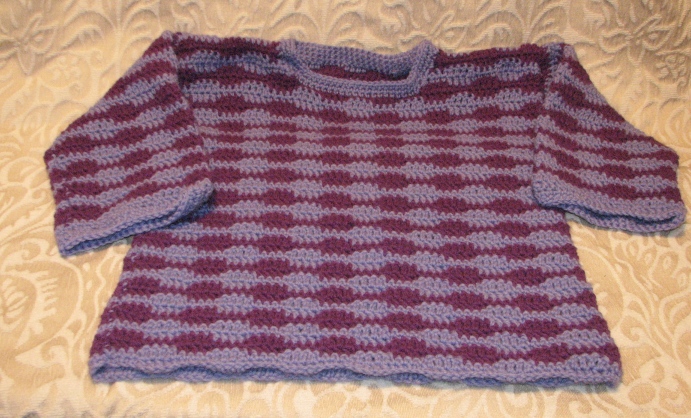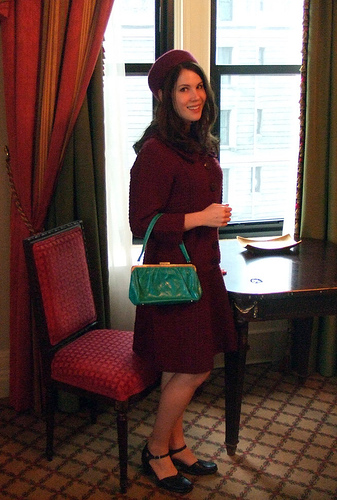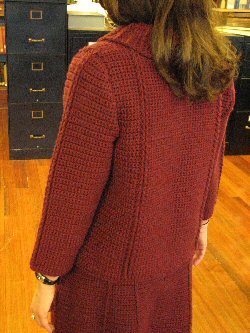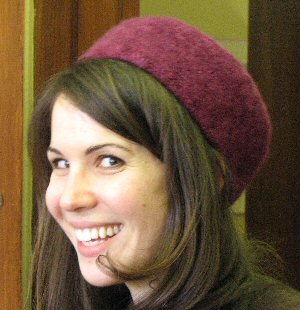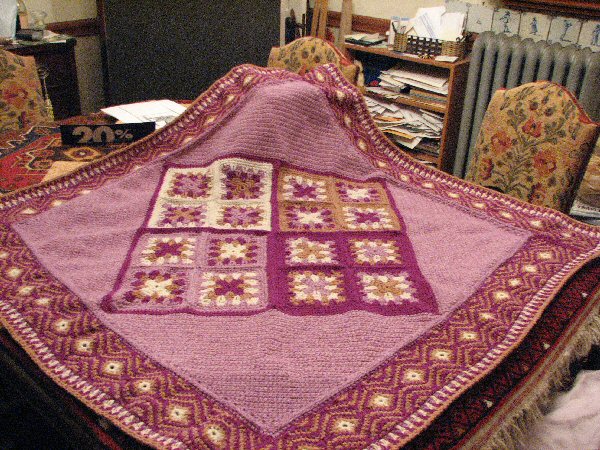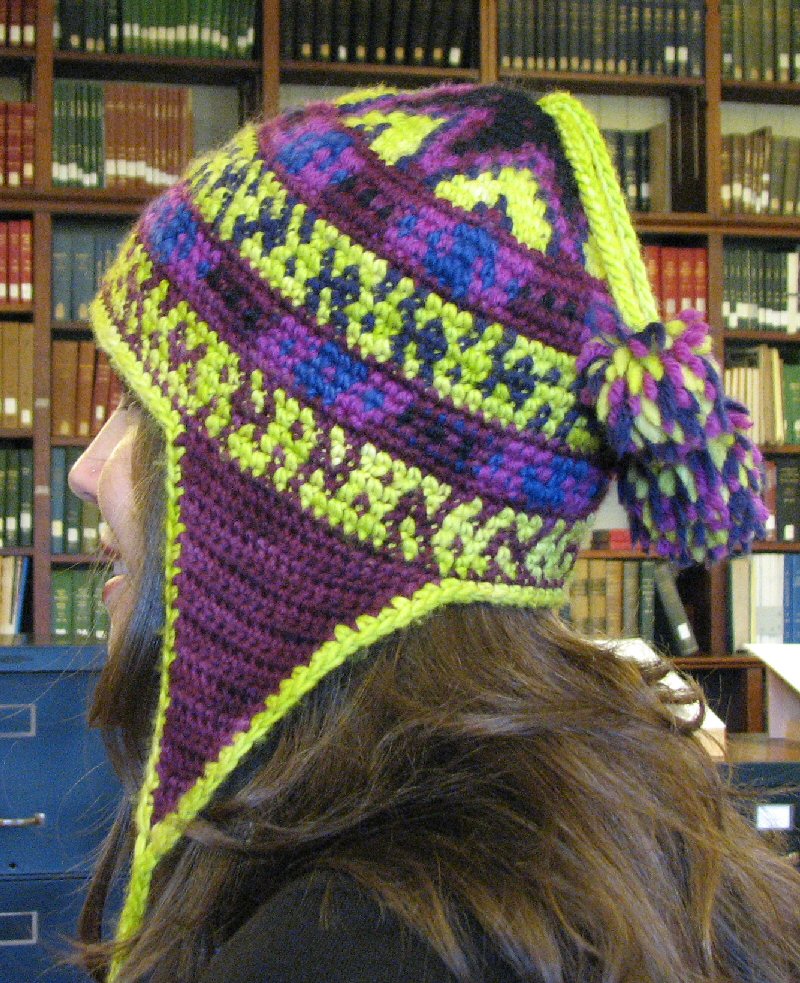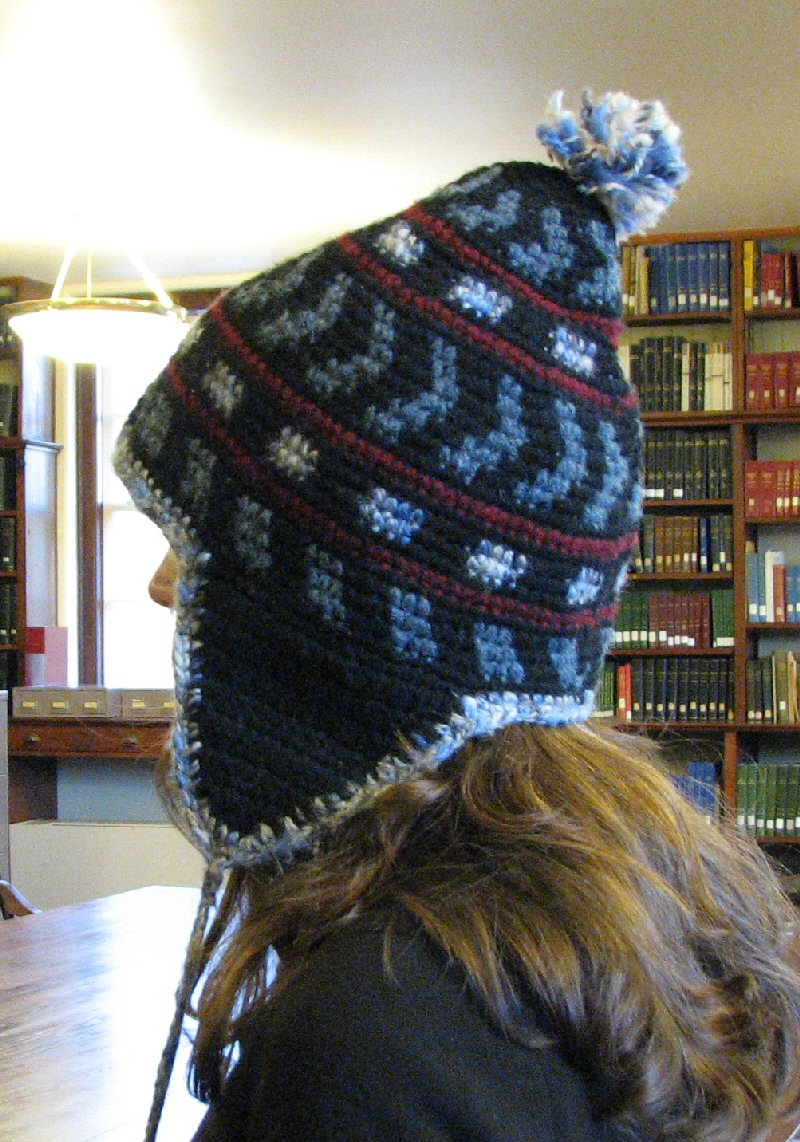 Prototype #1
Prototype #1This was my first attempt at making a top-down raglan sweater pattern. These are my notes -- although it looks nice and is wearable, there were some issues with it as a pattern so I don't recommend that anybody follow these instructions until I have cleaned them up and validated a good, reproducible pattern with another prototype.
update:
working on prototype #2, the simplest fix for the issues mentioned above seems to be to use an H hook for the BLO yoke part, G for the body, and F for the ribbing at the ends of sleeves & body. The changed instructions are highlighted in red. Still needs more testing.update 2: more modifications made to the pattern to allow for more room over the shoulder.
goals:
- top-down, one-piece raglan sweater with no seam sewing.
- good coverage for cold weather, a placket and collar like a polo shirt rather than a v-neck or crew neck.
- dense fabric for warmth -- no holes or lacy stitches
- ribbing to keep in warmth
- easy stitches, but possible to embellish with decorative stitches if so desired
- lends itself to using multiple colors, partial skeins, etc., but can also be made in one color
- knitting worsted weight
materials: I started with leftover Caron Simply Soft Brites yarn from the previous baby shower blanket. Each skein was 6 oz. originally, mostly intact (perhaps 5 oz left). The Blue Mint and Iris were larger, complete skeins. There was some Blue Mint leftover, but not enough to matter. Everything else was used up completely.
Caron Simply Soft "Brites", Grape - 6 oz. (color A)
Caron Simply Soft "Brites", Watermelon - 6 oz. (color B)
Caron Simply Soft "Brites", Lemondate - 6 oz. (color C)
Caron Simply Soft, Blue Mint - 7 oz. (color D)
Caron Simply Soft, Iris - 7 oz. (color E)
crochet hook size
H, G and F.
4 buttons.
size: this makes a sweater suitable for a size 8-10 child. One of the issues with the pattern that needs to be fixed for a "production version" is that the yoke, made in back-loop-only single crochet (BLO sc), works up to a narrower gauge than ordinary single crochet. For me, that was about 9 st to 2" for the BLO sc, and 8 st to 2" with ordinary sc. With a top-down raglan, the proportions of the yoke dictate the shape and size of the whole sweater. I worked to
CYCA measurements based on the yoke. When I switched to sc for the decorative stitches, the body became wider than the yoke. When put on a size 8 child (which I did not get to do until it was almost completely done), the yoke part fit nicely, but the body was overly loose. When put on a size 12 child, the body was fine, but the fit over the shoulders was snug.
update: this gauge situation may be fixed by using an H hook for the BLO yoke, a G hook for the body, and F hook for the sleeve & bottom ribbing. But is is important to check one's gauge for each section and adjust appropriately.
gauge:
8 BLO sc = 2"
with H hook, with G hook 8 sc = 2", 9 rows of sc = 2"
Notes:
The key to a top-down raglan is that it is worked in one piece, with 4 "corners" where all the increases are made. The corners give the effect of a 45 degree angle "seam." When the yoke has reached the point where it is large enough that the corners can meet under the arm, the corners are joined and the body and sleeves are then worked in the round.
This sweater is worked starting at the center front neck opening. In order to make a nice rounded neck opening, this part of the sweater will be shaped over the succeeding rounds with increases at the front until the front opening is the proper size. Once the yoke has reached the size needed to fit under the arm and be joined, a collar and placket will be added. The plackets will be overlapped and crocheted together when the first body round begins.
work over all ends as you go.
stitches:BLO sc -- work single crochet in back loop only of stitch below
raglan inc -- 3 BLO sc in center of group of 3 st in row below
front neck inc -- 2 BLO sc in first and last st of row
fpdc -- front post double crochet.
bpdc -- back post double crochet.
-- insert hook in sc 2 rows below, draw up loop to level of current row, YO and draw through both loops on hook
sc dec -- single crochet decrease. insert hook in next st and draw up loop, insert hook in st after that and draw up loop, YO and through all loops on hook
make yoke:with color A and hook
H, ch
43row 1: 3sc in second ch from hook, sc in next
10ch, 3 sc in next ch, sc in next 18 ch, 3 sc in next ch, sc in next
10 ch, 3 sc in last ch, ch 1 turn [
50 st in row]
row 2: 2 BLO sc in first st (
front neck inc made), 3 BLO sc (
raglan inc made) in next st, BLO sc in next
12 st, raglan inc, BLO sc in next 20 st, raglan inc, BLO sc in next
12 st, raglan inc, front neck inc, ch1 turn [
60 st in row]
row 3: front neck inc, BLO sc to center of previous raglan inc, raglan inc in center st, BLO sc to center of previous raglan inc, raglan inc, BLO sc to center of previous raglan inc, raglan inc, BLO sc to center of previous raglan inc, raglan inc, BLO sc to last st, front neck inc, ch1 turn.
row 4-
8: continue working as for previous row, making front neck inc at beginning and end of each row and raglan inc in center of raglan inc of previous row until end of row
8.
row
9: front opening will be worked even from now on, no more front neck inc at beginning and end of rows. BLO sc in next st, continue in established pattern to end of row, ch 1 turn.
row
10-
26: work as for row 8. At end of
row 26 there should be a total of
32 st across each front piece (excluding corner),
70 st across the back (excluding corner), and
62 st across each shoulder (excluding corner). At the end of row
26, fasten off.
collar:with color B and hook
H:
collar row 1: attach yarn to wrong side of front neck opening, ch 3 (counts as first dc), dc in side of next
7 rows, dc in back of starting chain all around side and back of neck, dc in side of next
8 rows, ch 3, turn. Ch 3 counts as first dc of next row.
row 2: work *fpdc in next st, bpdc in next st, repeat from * to end, ch 3, turn.
row 3-4: work fpdc around each bpdc st in previous row and bpdc around each fpdc st in previous row. ch3, turn at end of row, ch3 counts as first dc of next row.
fasten off.
right placket:
with color B and hook
H:
right placket row 1: attach yarn to bottom of right-hand front opening on front side, sc in side of each yoke row up to collar, make 2 sc in side of each row of collar, ch 1 turn.
row 2: sc in each sc to end, ch 1, turn
row 3: if sweater is for a girl, work buttonholes in this row as follows: *sc in next 3 st, ch 3, skip 3 st, repeat from * 4 times, sc in each st to end, ch 1, turn.
row 4-5: repeat row 2, fasten off
left placket:left placket row 1: attach yarn to top of left-hand collar edge on front side, 2 sc in side of each collar row, sc in side of each yoke row to end, ch 1, turn
row 2: sc in each sc to end, ch 1, turn
row 3: if sweater is for a boy, work buttonholes in this row as follows: *sc in next 3 st, ch 3, skip 3 st, repeat from * 4 times, sc in each st to end, ch 1, turn.
row 4-5: repeat row 2, fasten off
join yoke and begin body:overlap plackets with buttonholes on top, pin in place. Plackets should overlap so that the placket adds 4 stitches to the total size of the front section. (note that plackets are 5 rows wide).
Change to size G Hook, attach color C to back underarm corner on the right side.
body row 1: sc in corner and each st across back to next corner (
72 st). skip shoulder stitches (58 st), sc in next corner st, sc in each st across front to placket (
106 st), work 4 sc in end of rows of placket, working through both layers of overlapped placket to next corner st (
144 st), sl st to starting st, ch 1, turn.
row 2-3: sc in each st across. Join all rows with sl st, ch1, turn.
row 4: sc in next 2 st,*ch 1, skip st, sc in next 3 st, repeat from * to end, sc in last st. sl st to join, fasten off.
row 5: attach color B. sc in next st, *long sc over ch into sc 2 rows below, sc in next 3 st, repeat from * around, sc in last 2 st, sl st to join, ch 1, turn.
row 6: *ch 1, skip st, sc in next 3 st, repeat around to end, sl st to join, fasten off.
row 7: attach color D. *long sc over ch to sc 2 rows below, sc in next 3 st, repeat from * around, sl st to join, ch 1, turn.
row 8: repeat row 4.
row 9-10: attach color C. repeat row 5-6, do not fasten off.
row 11-12: repeat row 2-3, fasten off.
row 13-16: attach color D.
repeat row 2 for 4 rows, fasten off.
row 17-28: repeat color sequence from rows 1-12, reversing color B and color C.
row 29-74: attach color E. repeat row 2 until length from underarm is 14 1/2".
bottom ribbing:using
F hook, attach color D to right side of work.
row 1: dc in each st around, sl st to join, ch 3, turn (ch3 counts as first dc of next row)
row 2: *fpdc in next dc, bpdc in next st, repeat from * around, sl st to join, ch 3, turn.
row 3-5: bpdc in each fpdc in row below, fpdc in each bpdc in row below, sl st to join, ch3, turn.
fasten off at end of last row.
sleeves:
Use size G hookrow1: attach color C to underarm corner, sc in each st around shoulder side of yoke to form sleeve, sl st to join, ch 1, turn. (
64 st)
Decrease as you go: Work as for body, but taper sleeve by making sc dec at beginning and end of rows every 4th row until 36 st remain in sleeve, then work even with 36 st around.
row 2-28: repeat body pattern rows 2-28.
row 29-32: repeat rows 13-16.
row 33:-64: repeat patterns rows 1-36, until length from top of yoke to end of sleeve is 14 1/2".
sleeve ribbing:use F hookrow 1: with last color used, work row of sc around bottom of sleeve, making 8 sc decreases evenly spaced.
row 2-7: attach color C, work as for bottom ribbing.
Make another sleeve for the other side.
finishing:
weave in any remaining ends.
sew buttons to placket to match buttonholes.
block.












